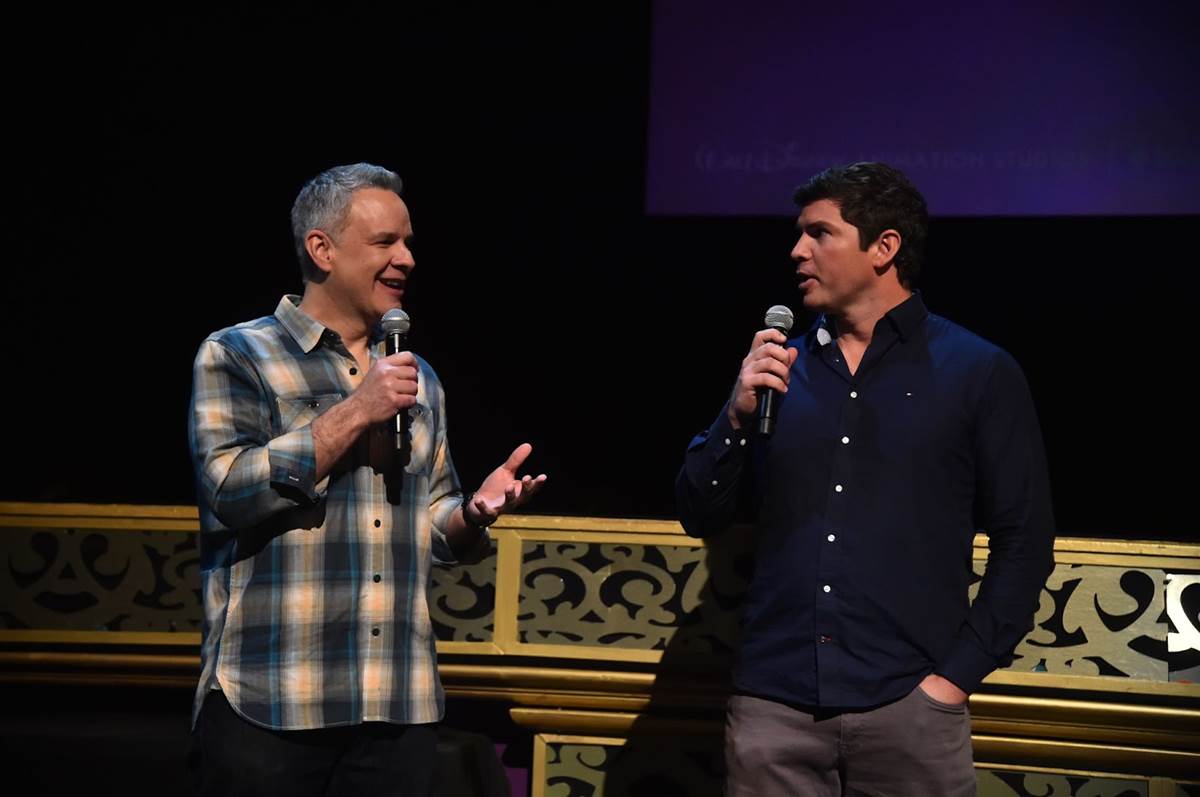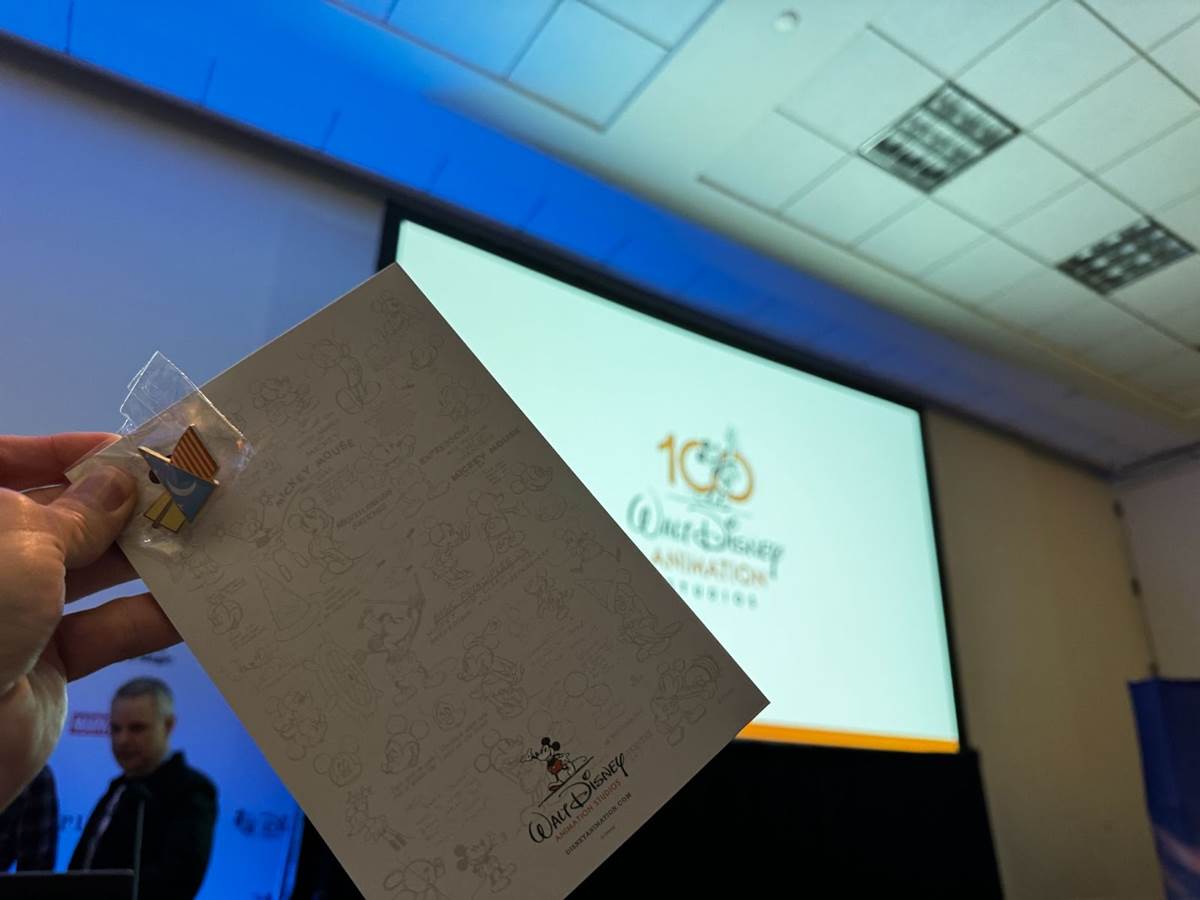Walt Disney Animation Studios’ centennial short film, Once Upon a Studio, already feels like it’s breaking the fourth wall a bit when classic animated characters spring to life within the halls of the Roy E. Disney building. But naturally, it took a lot of hard work and talent to create the film, which combines live-action, computer-generated characters, and traditional hand-drawn animation. At LightBox Expo, directors Dan Abraham and Trent Correy joined producers Yvette Merino and Brad Simonsen to present “The Making of Once Upon a Studio.”
Brainstormed in secret during the pandemic by Dan Abraham and Trent Correy, the directing duo behind Once Upon a Snowman wanted to meet face-to-face during a time of social distancing. Their solution: Taco Bell. They would each go through the drive-thru for some soft shell tacos, park next to each other, and roll down their windows to discuss ideas while thinking “outside the bun.” By October 2021, they had a rough storyboard outline, which Dan and Trent pitched to Disney Animations Chief Creative Officer, Jennifer Lee, who was determined to get the film made.
With so many future story artists in the room, Dan Abraham gave the LightBox Expo crowd a taste of the pitch they made to Jennifer Lee. Dan ran through the final sequence, singing “When You Wish Upon a Star” and emulating character voices. As this was an early iteration of the finale, there were a few changes from the finished film. The biggest difference to me was the lack of Ariel singing, which, although Scuttle still interjected his “Whaa”’s from the branch of a tree from Flowers and Trees. And instead of Pocahontas singing on her knee to smaller characters, it was Moana.
One of the lofty goals of the short was to have hand-drawn animators of the past return to the studio, animating on actual paper. James Baxter (Rafiki in The Lion King, Quasimodo in The Hunchback of Notre Dame) handled Peter Pan flying up inside the Sorcerer Hat, followed by Wendy, Michael, and John. Eric Goldberg, who is still active at the studio, animated the Mad Hatter in a complicated sequence that also involved Mario Furmanczyk, who animates in both 2D and CG, who helped with the handoff of Flounder between Moana (CG) and Mad Hatter (2D). And, walking through the background of the shot is a penguin from Mary Poppins, animated by none other than director Trent Correy, who originally studied hand-drawn animation. Dan Abraham’s animation career began as a cleanup artist on Space Jam (along with Eric Goldberg), so he helped his fellow director clean up his animation. As for Mickey and Minnie Mouse, Eric Goldberg saw the potential in a recent alumni of Disney Animation’s apprenticeship program, Austin Traylor, who had the honor of animating the two icons coming to life in one of the first animated shots of the short. Dan and Trent also gave a shoutout to CG Animation Supervisor Andrew Feliciano for helping to tie all of the elements together in what was one of the most complicated shots in the film.
Speaking of Mickey Mouse, Dan Abraham was convinced that the dialogue he wrote for Mickey to deliver to a portrait of Walt Disney would need to be amended. He knew that if it were too short, it wouldn’t pay off, but if it went on too long, it would be schmaltzy. He was surprised that when “Feed the Birds” was placed under the dialogue, what he wrote felt right. But the icing on the cake was when Matthew Walker, Senior Vice-President of Music for Disney and Pixar Animation Studios, suggested they get Richard Sherman to return to the studio to play the melody on the piano in Walt Disney’s restored office.
Staying on the topic of Mickey, fans were quick to note that the current official voice of Mickey (Bret Iwan) wasn’t used for this project. In his place is Chris Diamantopoulos, who provided a more frantic voice for Paul Rudish’s short series from Disney Television Animation. During the Q&A portion of the panel, a fan asked what went into that decision. The directors shared that Chris, being the Disney fan that he is, sent in a tape of himself dubbing over scenes from classic Mickey Mouse shorts, many of which sounded like Walt’s version of Mickey’s voice. Not only did it feel right for the short, but the directors added that while recording the line delivered to Walt’s portrait, Chris choked up in the booth. Another anecdote about the voice recording sessions was that many of the actors reprising their roles were surprised to find that they only had one line. “Idina Menzel’s only got two words,” Dan would say to make them feel better… a line that didn’t work when it came time to actually record Idina Menzel’s dialogue! (Her two words: “Not all”).
The complexities of blending live-action, hand-drawn, and computer-animated imagery required a lot of technical wizardry. Producers Yvette Merino and Brad Simonsen tasked Dan and Trent with going throughout the studio and taking pictures of anywhere they planned to set a scene. The interior of the animation building was then scanned with lidar to create a 3D map that would help determine camera movements. And then, live-action plates could be filmed, with just a few locations requiring the creation of a computer-generated background as a stand-in.
At one point during the presentation, Dan and Trent showed an example of the annual group photo the entire team at Walt Disney Animation Studios takes outside the sorcerer hat annually, which inspired the animated character group photo in the short. By comparison, Yvette Merino showed a similar photo of the extensive legal team that helped Once Upon a Studio get made. Disney Animation’s mighty legal team is just 8 people, but with 100 years of history to go through, they quickly found themselves emailing their corporate colleagues across Riverside Dr. No photos were allowed during the panel, but it was fun to see these legal experts celebrating their victory after clearing over 500 characters to appear in the short.
Once Upon a Studio is a passion project in every sense, and not just for the directors and producers. All of the artists at Walt Disney Animation Studios got behind the project, volunteering to help in any way they could, including inking and painting the hand-drawn characters. Dan and Trent wanted each character to feel of the era they were animated in, intentionally avoiding any highlights like in Who Framed Roger Rabbit. Instead, lighting technicians applied some shading to help them not feel flat, while still retaining the visual aesthetic each character is known for.
When it comes to Once Upon a Studio, an hour isn’t enough time. I’m sure there are more fascinating stories behind the scenes of this production, but it was great to learn more about the love and attention to detail that went into crafting the perfect love letter to the animators of the past, and in particular, Burny Mattinson, to whom the short is dedicated.
Click here for more coverage from LightBox Expo.


